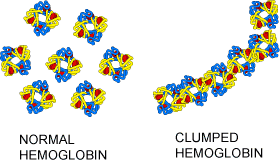
Where is it found?


How is sickle cell disease acquired?
In these Punnett squares, the capital letter "S" represents a normal HBB gene. The lowercase letter "s" represents the mutated HBB gene that causes SCD.
The first square shows two parents that are both carriers, while the second shows a parent that has SCD and one that is completely free of the disease.
Sickle cell disease is an inherited disease, specifically, an autosomal recessive disease. Being an autosomal recessive disease, the patient must have two copies of the mutated gene, otherwise they will not be affected but will instead only carry the gene. SCD being an autosomal recessive disease also means that each parent must be carriers or have the disease themselves, otherwise the child will be without the trait for the disease or the disease.
The mutated gene of SCD occurs in chromosome 11 in the HBB gene, also known as the following names: beta globin, β-globin, haemoglobin, beta, or haemoglobin subunit beta. In the chromosome, the HBB gene is found at 11p15.5, which is shown in the figure below. The HBB gene is the gene responsible for making a protein named beta-globin, hence the name; remember the difference. Beta-globin is one smaller part of a bigger protein known as hemoglobin, which is the protein found in your blood that transports oxygen throughout the body. In hemoglobin, there are two components that make up the hemoglobin, with two copies of each in the bigger protein. The other part is a unit called alpha-globin, which is usually unaffected by the mutated gene.
It’s still unclear why some races get SCD more than other races. In America, 1 out of 500 African-American babies are born with sickle cell disease. The rest of the world also has similar findings. According to many respected scientists, the statistics from their studies show that those from the following geographical areas are more likely to have this disease than others from other areas: Africa, India, the Caribbean, the Middle East, and the Mediterranean. However, scientists that study this occurrence have come up with a reason to explain why those areas have more cases of SCD than others: malaria. It’s been proven that mosquitoes carry the disease malaria and pass it to humans through blood, but there’s a hidden catch. Science is now proving that malaria can be prevented to an extent, and that’s by having the gene for SCD. Via the process of natural selection, those with the gene for SCD survive, and some that don’t have the trait and were lucky enough not to get malaria also survived. As the generations move forward, those that survive through their lives long enough reproduce with others that have survived as well. Among those are a large number of humans that either carry the gene, carry two copies of the gene, or don’t have it. Eventually, more and more children in those aforementioned areas are born with the trait or the disease and pass it on to their children.
There are actually many ways in which the HBB gene is mutated, but the one for SCD is most common in humans. That mutation usually causes the production of a beta-globin unit nicknamed hemoglobin S, or HbS for short. To make HbS, this mutation changes the glutamic acid normally found in the 6th position of beta-globin with valine. Naturally, that disrupts the formation of the red blood cell. Normally, the hemoglobin is in a round cluster, forming the regular shape of the red blood cell. However, with the HbS protein taking over the place of the usual beta-globin protein, that is no longer the case. This mutation causes the units of HbS to form rigid, long molecules in the hemoglobin. In turn, the long molecules of HbS alter the shape of the hemoglobin to make also make a long, rigid shape. The hemoglobin also shapes the red blood cell to some extent, making it into the sickled red blood cell that is associated with sickle cell disease. Above, you’ll see the formation of a regular red blood cell’s hemoglobin, and beside it is a sickle cell’s hemoglobin. The normal cluster of hemoglobin is round, forming the familiar shape of a red blood cell. To the right of it is a long cluster of hemoglobin, which forms the sickle celled blood cell.
Why do some races and areas of the world seem to get SCD more often than not?

How does the sickle shape form?
How does one get sickle cell disease?
In this section, you'll learn all about how someone can get sickle cell disease, as well as where it occurs the most in the world!
References
Autosomal recessive. (n.d.). - Glossary Entry. Retrieved April 11, 2014, from http://ghr.nlm.nih.gov/glossary=autosomalrecessive
Berkeley. (n.d.). Berkeley. Retrieved April 11, 2014, from http://evolution.berkeley.edu/evolibrary/images/evo/hemoglobin.gif
Genetics Home Reference. (n.d.). Genetics Home Reference. Retrieved April 11, 2014, from http://ghr.nlm.nih.gov/dynamicImages/chromomap/HBB.jpeg
HBB. (n.d.). - hemoglobin, beta. Retrieved April 11, 2014, from http://ghr.nlm.nih.gov/gene/HBB
How Do People Get Sickle Cell Disease?. (n.d.). How Do People Get Sickle Cell Disease?. Retrieved April 11, 2014, from http://sickle.bwh.harvard.edu/scd_inheritance.html
Learn.Genetics. (n.d.). Learn.Genetics. Retrieved April 11, 2014, from http://learn.genetics.utah.edu/content/disorders/singlegene/sicklecell/images/Autosomal%20Recessive.jpg
New global map shows distribution of sickle cell gene. (n.d.). New global map shows distribution of sickle cell gene. Retrieved April 11, 2014, from http://www.news-medical.net/news/20101103/New-global-map-shows-distribution-of-sickle-cell-gene.aspx?page=2
Piel, F., Patil, A., Howes, R., Nyangiri, O., Gething, P., Williams, T., et al. (n.d.). Abstract. National Center for Biotechnology Information. Retrieved April 11, 2014, from http://www.ncbi.nlm.nih.gov/pmc/articles/PMC3060623/
Sickle Cell Disease. (n.d.). Sickle Cell Disease. Retrieved April 11, 2014, from http://learn.genetics.utah.edu/content/disorders/singlegene/sicklecell/
natural selection. (n.d.). Dictionary.com. Retrieved April 11, 2014, from http://dictionary.reference.com/browse/natural+selection
